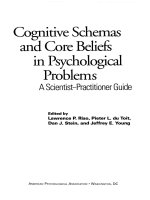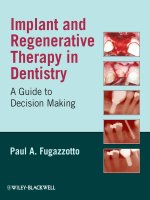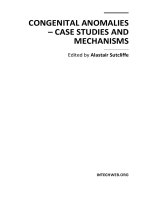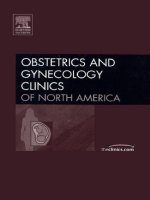Clinical and Molecular Advances in Ankylosing Spondylitis Edited by Jacome Bruges-Armas doc
Bạn đang xem bản rút gọn của tài liệu. Xem và tải ngay bản đầy đủ của tài liệu tại đây (6.71 MB, 178 trang )
CLINICAL AND MOLECULAR
ADVANCES IN ANKYLOSING
SPONDYLITIS
Edited by Jacome Bruges-Armas
Clinical and Molecular Advances in Ankylosing Spondylitis
Edited by Jacome Bruges-Armas
Published by InTech
Janeza Trdine 9, 51000 Rijeka, Croatia
Copyright © 2012 InTech
All chapters are Open Access distributed under the Creative Commons Attribution 3.0
license, which allows users to download, copy and build upon published articles even for
commercial purposes, as long as the author and publisher are properly credited, which
ensures maximum dissemination and a wider impact of our publications. After this work
has been published by InTech, authors have the right to republish it, in whole or part, in
any publication of which they are the author, and to make other personal use of the
work. Any republication, referencing or personal use of the work must explicitly identify
the original source.
As for readers, this license allows users to download, copy and build upon published
chapters even for commercial purposes, as long as the author and publisher are properly
credited, which ensures maximum dissemination and a wider impact of our publications.
Notice
Statements and opinions expressed in the chapters are these of the individual contributors
and not necessarily those of the editors or publisher. No responsibility is accepted for the
accuracy of information contained in the published chapters. The publisher assumes no
responsibility for any damage or injury to persons or property arising out of the use of any
materials, instructions, methods or ideas contained in the book.
Publishing Process Manager Ivana Zec
Technical Editor Teodora Smiljanic
Cover Designer InTech Design Team
First published February, 2012
Printed in Croatia
A free online edition of this book is available at www.intechopen.com
Additional hard copies can be obtained from
Clinical and Molecular Advances in Ankylosing Spondylitis,
Edited by Jacome Bruges-Armas
p. cm.
ISBN 978-953-51-0137-6
Contents
Preface IX
Part 1 Clinical Manifestations, Bone Density
Measurements and Axial Fractures Treatment 1
Chapter 1 Clinical Features of Ankylosing Spondylitis 3
Jeanette Wolf
Chapter 2 Ankylosing Apondylitis
of Temporomandibular Joint (TMJ) 15
Raveendra Manemi, Rooprashmi Kenchangoudar
and Peter Revington
Chapter 3 Bone Mineral Density Changes
in Patients with Spondyloarthropathies 27
Lina Vencevičienė, Rimantas Vencevičius
and Irena Butrimienė
Chapter 4 Surgical Treatment After Spinal Trauma
in Patients with Ankylosing Spondylitis 55
Stamatios A. Papadakis, Konstantinos Kateros, Spyridon Galanakos,
George Machairas, Pavlos Katonis and George Sapkas
Part 2 HLA and Non-MHC Genes,
Immune Response, and Gene Expression Studies 71
Chapter 5 HLA-B27 and Ankylosing Spondylitis 73
Wen-Chan Tsai
Chapter 6 Humoral Immune Response to Salmonella
Antigens and Polymorphisms in Receptors for
the Fc of IgG in Patients with Ankylosing Spondylitis 85
Ma. de Jesús Durán-Avelar, Norberto Vibanco-Pérez,
Angélica N. Rodríguez-Ocampo, Juan Manuel Agraz-Cibrian,
Salvador Peña-Virgen and José Francisco Zambrano-Zaragoza
VI Contents
Chapter 7 Genetics in Ankylosing Spondylitis – Beyond HLA-B*27
Bruno Filipe Bettencourt, Iris Foroni, Ana Rita Couto,
Manuela Lima and Jácome Bruges-Armas
Chapter 8 Lessons from Genomic Profiling in AS 135
Fernando M. Pimentel-Santos, Jaime C. Branco and Gethin Thomas
Preface
Ankylosing Spondylitis (AS) was first described possibly at the end of the XVII
century by Buckley (1931) and Connor, but it was only recognized after the radiologic
descriptions of Bechterew, Strumpell and Marie, during the XIX century. In 1964 the
American Rheumatism Association classified AS as a distinct disease. About forty
years ago (1973), Schlosstein and Brewerton published simultaneously but
independently the association of AS with the Class I allele B*27.
Since then, AS has been the target of intense research and an enormous amount of
information has been gathered about this disease. Now it is known that AS is one of a
group of several diseases known as Spondyloarthritis (SpA): AS, reactive arthritis,
unspecified spondyloarthritis, psoriatic arthritis, and entheropathic arthritis.
Also, during the last ten years research has been focused on the understanding of
the molecular and cellular processes involved in AS pathogenesis. Genome Wide
Association Studies (GWAS) were followed by other studies using candidate genes
which allowed the identification of non-HLA genes associated with AS
susceptibility.
The more detailed knowledge of the molecular and cellular mechanisms, and the
identification of biomarkers and their signaling pathways, contributed to the
development of anti-TNFα and anti-IL6 molecules which are highly effective in
the treatment of AS. These drugs radically changed the treatment of SpA and
improved significantly the quality of life of the patients. With the deeper
knowledge of the cellular mechanisms of AS, further therapeutic improvements
will follow.
In this book, we have tried through original research and revised chapters, to update
the clinical and molecular knowledge of AS and SpA.
The chapters in the first section, “Clinical Manifestations, Bone Density Measurements and
Axial Fractures Treatment”, cover general and more specific clinical aspects of SpA.
Spinal and axial joints are affected in AS, but the hallmark of this disease is the axial
aggression, sometimes restricted to the sacroiliac joint, better characterized in the early
stages by MRI. Peripheral joints may be involved in 30% of cases, and the earlier
X Preface
involvement of these joints may be an indicator of a more aggressive disease. Extra-
articular manifestations are quite common in AS, namely enthesitis, acute anterior
uveitis (AUU), cardiac involvement, pulmonary fibrosis, and secondary renal
amyloidosis. Psoriatic arthritis has several subgroups and the sub-classification of this
disease may be difficult even for the rheumatologist. Up to 50% of AS patients may
have gut inflammation when examined by colonoscopy, and SpA may be found in 1-
12% of patients with Crohn`s Disease and Ulcerative Colitis, with higher incidence of
peripheral arthritis; sacroiliitis may occur asymptomatic or with typical symptoms.
Reactive arthritis tends to be more aggressive and as a longer duration in HLA-B*27
positive cases (50%). Asymmetrical acute peripheral arthritis, enthesitis, acute
sacroiliitis, urogenital inflammation, and ocular manifestations are common and may
last several months to two years. The importance of clinical measurements to evaluate
pain, morning stiffness, and functional ability is well evaluated with the BASDAI and
BASFI questionnaires. Several measurements may be used by the clinician, to check
and control spinal function and flexibility.
The chapter on the incidence, clinical features, pathophysiology, signs, symptoms, and
current management of the Temporomandibular Joint (TMJ), reviews how AS affects
this joint. TMJ is involved in 4% to 32% of cases, and ranges from mild disease to
ankylosis which is exceptional. The non-surgical treatment of TMJ in AS is the most
effective way of managing over 80% of patients. Non-pharmacological treatment
includes fabrication of intra oral splints, physiotherapy, and patient education. The
pharmacological treatment includes NSAIDS, Coxibs, corticosteroids, and anti-TNF
agents. The surgical treatment – injection of steroids, joint lavage and total joint
replacement -, is indicated in patients with marked trismus, or in cases of the failure of
other non-surgical therapies.
The third chapter in this section is dedicated to bone mineral density (BMD) changes
in patients with SpA. BMD has been investigated mainly in patients with AS. The
authors investigated BMD changes in AS and in other diseases belonging to the SpA
group – ReA (Reactive Arthritis), PsA (Psoriatic Arthritis), EnA (Entheropathic
Arthritis) - to assess the relationship between changes in BMD and specific disease-
related variables like duration, physical disability and immobility, activity of the
disease, and medications. The results were also compared with a group of patients
with Rheumatoid Arthritis (RA) and healthy people. Several conclusions were
obtained but possibly the most relevant are: 1) BMD was identical between patients
with SpA and RA; 2) Similar changes were found in patients from the various SpA
groups.
The fourth and last chapter in this section is dedicated to surgical treatment in patients
with AS. Patients with AS may undergo a fracture with minimal or no history of
trauma, and the fracture should be considered as a high-risk injury. New back pain in
AS patients should be assumed to be caused by a fracture until proven otherwise. The
cervical spine is the most frequent fracture site (75%, C6-C7 and C7-D1) because the
Preface XI
anterior and posterior ligaments are more thoroughly ossified and resistant in the
thoracic and lumbar spine. Shearing fractures are the most unstable type of fractures
and serious complications are: severe neurological symptoms, haemothorax, or the
rupture of the aorta. Standard radiographs are inadequate to evaluate shearing
fractures due to osteoporosis and the position of the shoulders, and diagnosis may be
difficult due to pre-existing spinal alterations. The approach to treatment depends on
the type of injury, degree of spinal instability, and neurological status of the patient.
The operative treatment of these injuries is effective. Stabilization of fractures is better
performed with anterior and posterior support of the spine, but because of frequent
associated cardiovascular and pulmonary morbidities, this approach is not always
possible.
The second section “HLA and non-MHC genes, Immune Response, and Gene Expression
Studies” is dedicated to the molecular and immunological processes of AS. HLA-
B*27 is a unique HLA Class I molecule: anchoring peptides in the binding grove of B
pocket must have an arginine at the P2, and the free thiol Cys67 residue made B*27
easy to form homodimers in the extracellular domain. Twin studies suggest that the
HLA-B*27 accounts for more than 50% of AS susceptibility. Until July 2011, 82
subtypes were described based on nucleotide differences. HLA-B*27:05 is the
ancestral and most prevalent subtype in the majority of world populations. Several
subtypes are clearly disease associated, but B*27:06 and B*27:09 have been reported
not to be associated with AS and may have a protective role. According to some
authors the level of B27 mRNA may correlate with disease activity and several
theories have tried to explain the disease pathogenesis: molecular mimicry and
arthritogenic peptides, free heavy chain, and unfolded protein response were
considered main streams of hypothesis.
The second chapter in this section deals with the possibility that infectious agents may
have an important role as triggering factors for some autoimmune diseases like AS.
Previous work reported humoral immune responses to bacteria such as Klebsiella
pneumonia, Salmonella typhimurium, Shigella flexneri, Yersinia enterocolitica, and
Campylobacter jejuni. The authors reported that the 30 kDa band (p30) from S.
typhimurium could be differentially recognized by the immune response in AS
patients. In this chapter the authors have investigated whether the p30 antigen
recognized by AS patients is specific to S. typhimurium, or if it can be found in another
serovar of salmonella enterica. Twenty eight AS patients and 28 healthy controls were
investigated to analyze the IgG and IgA humoral immune response against Salmonella
enterica serovar enteritidis by western-blot. The immune response against S.
typhimurium appears to be strain specific; patients with AS produce IgG3 antibodies
against the p30 of S. typhimurium in contrast to healthy controls. The authors also
hypothesized that the relationship between the humoral response and the
pathogenesis of the disease could be due to FcR polymorphisms of IgG. The authors
suggest a link between humoral immune response in a susceptible individual and
FcRIII-150-VV.
XII Preface
Other HLA genes have been associated with AS susceptibility, like HLA-B*60 and
HLA-DRB1 alleles. A recent publication involving a Spanish/Portuguese cohort
reports the association with HLA-DPA1 and HLA-DPB1 alleles and AS. GWAS
supported the presence of non-MHC susceptibility genes and further studies narrow
down the chromosome areas first identified. ERAP1 (5q15) and IL23R (1p31.3) are the
most consistently non-MHC associated genes to AS. ERAP1 is a MHC class I
dependent aminopeptidase, and plays a major role in peptide trimming for
presentation at the cell surface. Recently it was shown that HLA-B*27 positive and
negative AS cases differ in association with ERAP1, suggesting that the mechanism by
which B*27 induces AS involves aberrant presentation or handling of peptides. IL23R
is a member of the haemopoietin receptor family, and genetic variants of this gene
have been reported in association with other autoimmune diseases such as
inflammatory bowel disease (IBD), psoriasis, and systemic sclerosis. The association of
several IL23R SNPs with AS was first reported by the Consortium WTCCC/TASC in
2007 and, since then, it has been replicated in several populations. The attributable risk
for this gene was calculated to be 9%. KIF21B belongs to a family of kinesin motor
proteins and was recently found with a strong association to AS in caucasians. Several
other genes are suggestively associated with the AS: IL-1 gene cluster, ANTXR2,
TNFSF15, TNFRSF1A, and TRADD.
The last chapter of this book explains the recent advances in molecular biology using
microarray-based genotyping and expressing assays which are ideal to investigate
diseases with underlying complex genetic causes. Microarray expression technology,
together with the most recent bioinformatics platforms, can be used for the detection
and quantification of differentially expressed genes but, according to the authors, the
success of the experiences greatly depends on whether the hypothesis and rationale
have been formulated through a clearly delineated question. Although significant
inter-individual variations on gene expression may occur, recent studies have been
focused on the investigation of gene expression patterns in peripheral blood to identify
systemic markers of the disease. Seven papers published since 2007 uncovered
pathways and potential biomarkers which may be useful for diagnosis and treatment
prediction on SpA. Consistent expression changes in genes such as TLRs, NLRP2 and
CLEC4D supports the importance of innate immune mechanisms in AS pathogenesis.
Other expression profiles include a pro-inflammatory signature in uSpA and AS, a
decreased immune responsiveness and immunosuppressive phenotypes, and two
bone remodeling signatures with over-expression of PCSK6, FREMEN1, and catenin
alpha-like 1 (CTNNAL1) genes in SpA patients or downregulation of SPOCK2, EP300
and PPP2R1A in AS patients, which are possible mediators in the ossification process.
A promising biomarker for early diagnostic of SpA is a member of the family of
regulators of G protein signaling (RGS1), although not confirmed in all studies to date.
The identification of biomarkers of treatment response to biologic therapies may
enable the more appropriate therapy to be chosen, contributing to a patient-specific
personalized medicine. LIGHT, RUNX2, and the CX3CL1-CC3CR1 complex may be
considered for treatment response in SpA patients.
Preface XIII
I am very grateful to all authors for their contribution to this textbook. I sincerely hope
that this volume Clinical and Molecular Advances in Ankylosing Spondylitis may help to
clarify some aspects of the disease contributing to a better understanding of AS
pathogenesis.
Dr Jacome Bruges-Armas
Hospital of the Holy Spirit, The Azores,
Portugal
Part 1
Clinical Manifestations, Bone Density
Measurements and Axial Fractures Treatment
1
Clinical Features of Ankylosing Spondylitis
Jeanette Wolf
5
th
Dep. of Inner Medicine
Wilhelminenspital
Vienna
Austria
1. Introduction
Ankylosing spondylitis is an inflammatory rheumatic disease, its cause is yet unknown, a
cross-reactivity of antibodies against germs and HLA-B27 is discussed, but not yet proven.
Ankylosing spondylitis belongs to the group of seronegative spondyloarthritides (Moll J,
Haslock I, Mac Rae IF, Wright V) (Wright V), there is a strong linkage to HLA-B27. Its
prevalence lies between 0.1% and 1% with a male predominance of 2-3: 1, the onset of
disease lies between 20 and 40 years, very seldom above the age of 45 (Wolf J, Fasching P).
So women are less frequently concerned, and the illness tends to take a milder course
(Sieper J, Braun J, Rudwaleit M, Boonen A, Zink A) (Gladman DD). On the other hand this
puts women to a disadvantage, as the disease is less easily detected, leading to an even
longer interval between disease onset and treatment.
General symptoms include morning stiffness of more than 60 minutes, fatigue, sometimes
even slightly elevated temperature, but the main initial symptom is low back pain at night
and in the morning. All patients with low back pain should be questioned about a positive
family history concerning rheumatic diseases, as the risk of developing this illness is higher
in patients where family members already have been diagnosed with ankylosing
spondylitis. This of course suggests a certain genetic disposition, especially if HLA-B27 is
involved (Van der Linden SM, Valkenburg HA, De Jongh BM, Cats A).
As a systemic inflammatory disease it is not restricted to a single organ or part of the body.
The following subchapters will deal with the different manifestations of this disease.
2. Spinal manifestations
The first symptoms of this disease are usually a low back pain with its peak at night and in
the morning and morning stiffness, which can last for hours. Both symptoms get better with
exercise, back pain can worsen with inactivity. Some patients show only a partial
involvement of the spine, in others the whole spine is involved. The physician always
should examine the patient´s back by patting it gently with one fist, starting at the cervical
spine all the way down to the sacrum, asking the patient, if and which part of the spine is
painful during this examination.
The disease is caused by chronic inflammation of the spinal joints and entheses, proliferative
synovitis and central cartilage fusion, which can lead to total destruction and ankylosis of
Clinical and Molecular Advances in Ankylosing Spondylitis
4
these joints. Fibroblast proliferation on the other hand leads to increased ossification
creating syndesmophytes (Figure 1) between the vertebral bodies and later on bamboo spine
(Figure 2). These cause an irreversible loss of spinal flexibility and movement, resulting in
the typical habitus still to be seen in older patients with a long disease duration due to
significantly enhanced kyphosis of the thoracic part of the spine and loss of lordosis of the
lumbal spine, finally making it impossible for the patient to bend any part of his spine.
Inflammation can also be found in the intervertebral disks resulting in discitis and
spondylitis, which can be seen as narrowing of the intervertebral space and destruction of
the adjacent cover plates. Seldom synovitis and osteitis can be found in the atlantoaxial area
leading to erosions and destruction of the lateral atlantoaxial joint. At the worst the joint is
destabilized, this may cause cord compression and neurological loss of function.
The costovertebral and costotransverse joints are quite commonly affected, being causal to
reduced chest expansion and decreased vital capacity of the lungs.
In some patients ankylosing spondylitis is restricted exclusively to an affection of the sacro-
iliac articulation (sacroiliitis), best shown by MRI, as it causes bone marrow edema and
cartilage changes. X-ray takes a long time to reveal this arthritis, because there only bone
destruction and ankylosis are visible, these are not seen in the early stages of the disease. In
the end sacroiliitis can lead to total destruction and ankylosis of the sacroiliacal joint, then of
course it is clearly visible in x-ray (Figure 3). Active sacroiliitis can lead to local pressure
pain and pain associated with movements of the pelvis.
Finally kyphosis of the thoracic spine, obliteration of the lumbal lordosis and forward stoop
of the neck occur, these signs are irreversible. Due to osteoporosis even minor trauma may
result in spinal fractures, causing a rapid and significant increase in pain. Fracture
fragments can be dislocated and lead to cord compression.
3. Peripheral joints
Almost half of the patients experience arthritis in the hips or the shoulders. Up to 30% of the
patients suffer from small joint involvement with swelling, pain and stiffness in the
inflamed joints. Often these appear as asymmetrical oligoarthritis. Usually they are non-
erosive, but deformity and consequently destruction of the hips have been seen. An early
involvement of peripheral joints can be an indicator of a more aggressive progress.
Peripheral joint involvement can occur at any stage of the disease (Sieper J, Braun J,
Rudwaleit M, Boonen A, Zink A) (Gladman DD).
4. Extra- articular manifestations
Quite common there is an involvement of the enthesis, meaning the insertion of tendons,
ligaments and capsules into the bone. These inflammatory changes are referred to as
enthesitis (Francois RJ, Braun J, Khan MA). Any enthesis may be concerned, but most
frequently an enthesitis of the Achilles tendon is found. Enthesitis causes pain, swelling and
thickening as well as loss of function, it can occur all of a sudden, but is found quite often as
a chronic inflammation, which can finally lead to rupture of the tendon. Arthritis of the
adjacent joint has also been described, enthesitis is presumed to be the starting point of joint
inflammation (McGonagle D, Gibbon W, Emery P)
Clinical Features of Ankylosing Spondylitis
5
Fig. 1. Syndesmophytes.
Clinical and Molecular Advances in Ankylosing Spondylitis
6
Fig 2. Bamboo stick.
Clinical Features of Ankylosing Spondylitis
7
Fig. 3. Ankylosis caused by sacroiliits.
Up to 40% of all patients suffer from acute anterior uveitis at least once in their lifetime
(Rosenbaum JT). Uveitis occurs usually unilateral, symptoms include pain, redness, reduced
sight, photophobia, grittiness, myosis and increased lacrimation. It is self-limiting, but tends
to reoccur. Untreated it may lead to complications like synechia and cataract. Patients have
to be advised to see a doctor immediately after onset of the above mentioned symptoms.
Another extra-articular manifestation is aortitis and/or aortic regurgitation. Approximately
9% of ankylosing spondylitis patients are concerned. Aortitis can be seen in
echocardiography showing thickening of the aortic wall and dilatation of the aortic root,
thickening of the aortic valves causing aortic insufficiency (2-10% of the patients). 1-9%
acquire a complete heart block, mainly located in the atrioventricular node (Bergfeldt L).
The lungs are usually only concerned indirectly because of involvement of the
costovertebral and costotransverse joints and therefore reduction of chest expansion leading
to reduced vital capacity. This can be detected by pulmonary function testing. But
pulmonary participation like upper lobe fibrosis and pleural thickening has been described,
these can be detected by high-resolution computed tomography (Maghraoui AE, Chaouir S,
Abid A et al) (Souza AS, Muller NL, Marchiori E, Soares-Souza LV). These findings are
usually clinically asymptomatic, yet fibrosis tends to progress over time.
4-9% of the patients develop a secondary renal amyloidosis as part of the autoimmune
disease, yet primarily, renal involvement is rather uncommon in ankylosing spondylitis.
Renal amyloidosis may occur in patients with long disease duration (Nabokov AV,
Shabunin MA, Smirnov AV).
Due to chronic pain, patients with ankylosing spondylitis often depend upon painkillers.
Especially non-steroidal anti-inflammatory drugs (NSAIDs) are prescribed, as these agents
Clinical and Molecular Advances in Ankylosing Spondylitis
8
reduce pain, but also inflammation itself. Long-term intake of this medication is generally
recommended, as trials have shown a significantly better effect on pain in comparison to
placebo (Dougados M, Dijkmans B, Kan M, Maksymowych W, Van der Linden S, Brandt J)
(Van der Heijde D, Baraf HS, Ramos-Remus C et al). Some studies even reported a decrease
of spinal ossification, if the drug was taken on a regular basis (Boersma JW) (Wanders A,
Van der Heijde D, Landewe R et al). On the other hand, NSAID induced nephropathy can
occur in older patients with a longer disease duration and after several weeks or months of
NSAID use, independent of the primal medical cause for painkillers. NSAIDs have to be
discontinued in these cases. However, renal parameters should be checked on a regular
basis in all patients with ankylosing spondylitis.
In up to half of the patients osteoporosis can be found, yet DEXA can be falsified by
syndesmophytes, creating the impression of a higher bone density. Bone fracture caused by
even minor traumatic events can lead to a sudden increase of pain. The same applies to
fractures of the syndesmophytes themselves. Most frequently fractures of the cervical spine
are observed, followed by the thoracolumbar region (Feldtkeller E, Vosse D, Geusens P, Van
der Linden S). Osteoporosis may be induced by an imbalance between osteoblasts and
osteoclasts in favour of the osteoclasts (Obermayer-Pietsch BM, Lange U, Tauber G et al).
Decreased mobility may also play its part in the development of osteoporosis.
5. Disease impact
Fatigue and sleeping disorders are quite common in patients with ankylosing spondylitis
(Jones SD, Koh WH, Steiner A, Garrett SL, Calin A) (Hultgren S, Broma JE, Gudbjornsson B,
Hetta J, Lindqvist U), they can even lead to depression (Barlow JH, Macey SJ, Struthers GR)
as well as reduced fitness and working capacity. Fatigue is a typical symptom of ankylosing
spondylitis, therefore it has been included in the BASDAI, a patient´s questionnaire (Garrett
S, Jenkinson T, Kennedy LG, Whitelock H, Gaisford P, Calin A). It seems to correlate with
disease activity (Günaydin R, Göksel Karatepe A, Cesmeli N, Kaya T) and aggravates the
difficulties patients already experience in daily life activities due to pain and reduced
mobility. Sleep disturbance is caused by low back pain that typically begins at night and
keeps the patient from having a restful sleep, but also by depression and anxiety. The
combination of chronic disease, chronic pain and ensuing disability can lead to depression,
for the patient is no longer able to perform activities of daily life the way he or she wishes to
and may not be able to work full-time or even fears to lose his or her job because of reduced
mobility and flexibility. Ankylosing spondylitis has a highly individual disease course and
duration, some patients show only minor symptoms and restrictions, while others suffer
very badly. Work disability is higher in patients with longer disease duration, inflammation
of peripheral joints, lower level of education, high pain levels and physically straining jobs.
Patients with long disease duration and difficult to treat back pain are more prone to
develop depression than patients with no or only light pain and symptoms (Baysal O,
Durmus B, Ersoy Y, Altay Z, Senel K, Nas K, Ugur M, Kaya A, Gür A, Erdal A, Ardicoglu O,
Tekeoglu I Cevik R, Yildirim K, Kamnli A, Sarac AJ, Karatay S Ozgocmen S). The degree of
disease activity also seems to correlate with anxiety and health status. Patients with higher
disease activity scores were more anxious and more depressed (Martindale J, Smith J, Sutton
CJ, Grennan D, Goodacre L, Goodacre JA).
Clinical Features of Ankylosing Spondylitis
9
Neurological symptoms are caused by complications of long-ongoing disease. Due to
osteoporosis spinal fractures may occur, leading to suddenly increasing back pain in the
afflicted region. If a fracture fragment is dislocated, it may injure the spinal cord and
subsequently cause neurological symptoms. The cauda equina syndrome is evoked by dural
ectasia, usually a late manifestation of the illness (Ahn NU, Ahn UM, Nallamshetty L,
Springer BD, Buchowski JM), leading to sensory and / or motor loss of function and finally
sphincter dysfunction. Patients may also develop pain in the rectum or the lower limbs.
Atlantoaxial subluxation on the other hand may cause neurological symptoms in one or
both arms. 2% of all patients with ankylosing spondylitis are concerned, but not all of them
show signs of cord compression (Chou LW, Lo SF, Kao MJ, Jim YF, Cho DY). Subluxation
may be caused by transverse or posterior longitudinal ligament damage or local
atlantodental synovitis as well as somatic stress caused by increased kyphosis of the cervical
spine.
6. Ankylosing spondylitis and other seronegative spondyloarthritides
Ankylosing spondylitis belongs to the group of seronegative spondyloarthritides together
with psoriatic arthritis, reactive arthritis and unspecified spondyloarthritis. They all lack
rheumatoid factor, thus being seronegative. Ankylosing spondylitis has also been seen in
combination with psoriatic arthritis or enteropathic arthropathies like Crohn´s Disease and
ulcerative colitis.
Peripheral asymmetrical arthritis is seen in approximately 50% of patients with psoriatic
arthritis. As this disease can also include axial manifestations, a thorough skin examination
has to be done in any patient with low back pain. 20 to 40% of patients with psoriatic
arthritis suffer from sacroiliitis (Gladman DD, Shuckett R, Russell ML et al) (Torre Alonso
JC, Rodriguez Perez A, Arribas Castrillo JM et al). There is also a tendency of cervical spine
involvement and asymmetrical affliction (Jenkinson T, Armas J, Evison G et al). Psoriatic
arthritis can cause monoarthritis, dactylitis, asymmetrical oligoarthritis and enthesitis, up to
25% of patients with psoriatic arthritis are HLA-B27 positive, but in patients with spinal
inflammation up to 70% are HLA-B27 positive. On the other hand, there are patients who
show no or only minimal skin affection at the onset of arthritis, making it even more
difficult to find the right diagnosis. The transition between these two diseases is gradual and
can differ greatly between two individuals. Some patients show definite signs and
symptoms of ankylosing spondylitis with only marginal involvement of the skin and
peripheral joints, others mainly present skin and joint affections with only little back pain. In
these cases, it is quite easy to diagnose ankylosing spondylitis in combination with psoriasis
or psoriatic arthritis with axial manifestations. But other individuals are not as easily
diagnosed, especially if all symptoms are equally strong or weak or if there is no skin
involvement at all. So sometimes it can be difficult even for the rheumatologist to
differentiate between these two diseases. Yet this is of importance concerning the choice of
treatment: while psoriatic arthritis can be treated with Disease Modifying Anti-Rheumatic
Drugs (DMARDs) like Methotrexate or Leflunomide, these agents have no effect on
peripheral arthritis caused by ankylosing spondylitis.
Spondyloarthritis can be found in both Crohn´s Disease and ulcerative colitis. The incidence
lies at 1-12%. Up to 50% of the patients also develop peripheral arthritis. Both are
autoimmune diseases, yet the pathogenesis is still largely unclear. Peripheral arthritis can
Clinical and Molecular Advances in Ankylosing Spondylitis
10
appear before the onset of bowel symptoms, causing acute, but self-limiting attacks of
monoarthritis or asymmetrical oligoarthritis as well as chronic arthritis. Hips and shoulders
are less frequently affected as in ankylosing arthritis. A flare of the bowel disease can be
accompanied by another flare of arthritis. Enthesitis of the Achilles tendon has been
reported. Sacroiliitis can occur asymptomatic or with the typical signs of low back pain,
stiffness and reduction of spinal mobility. Spondylitis is independent of gut flares. Up to
50% of patients with ankylosing spondylitis on the other hand are diagnosed with gut
inflammation when examined by colonoscopy (De Kaiser F, Baeten D, Van De Bosch F et al).
Reactive arthritis is another disease belonging to the group of seronegative
spondyloarthritides and usually leads to asymmetrical peripheral arthritis lasting for several
months up to one or two years. Acute inflammation, swelling and pain of the joints,
dactylitis and enthesitis are the main symptoms. Any joint can be affected, but most
commonly knees, ankles and metatarsophalangeal joints. Later on, osteoarthritis may
develop in formerly affected joints. Patients also suffer from fatigue, fever and malaise. Low
back pain is rather common in these patients, caused by acute sacroiliitis, enthesitis and
muscle tension. Spondylitis and sacroiliitis tend to be asymmetrical, but normally they do
not lead to spinal fusion and ankylosis. There is a correlation between reactive arthritis,
HLA-B27 and a previous infection (Khan MA) (Silman AJ, Hochberg MD), yet no germ can
be found in any of the affected joints. Skin and mucous membrane lesions, sterile urogenital
inflammation, sterile conjunctivitis, but also acute anterior uveitis and keratitis may occur
(Saari KM). As ocular manifestations tend to reoccur, patients have to be advised to see an
ophthalmologist immediately upon onset of ocular symptoms. X-ray will not be very helpful
in acute sacroiliitis, but it can help to detect signs of previous sacroiliac inflammation. Back
pain may persist even after disappearance of arthritis. In some patients ankylosing
spondylitis subsequently evolves, but it is unclear whether reactive arthritis is the
predecessor or if this is just a coincidence. Reactive arthritis tends to show a more aggressive
and longer disease course when HLA-B27 positive, but at least 50% are HLA-B27 negative,
so it should not be tested on a regular basis, as the result could be misleading.
7. Clinical measurements for ankylosing spondylitis
In order to evaluate pain, morning stiffness and functional ability two different
questionnaires have been developed: the BASDAI (Bath Ankylosing Spondylitis Disease
Activity Index) and the BASFI (Bath Ankylosing Spondylitis Functional Index). Both are
questionnaires that have to be completed by the patient.
The BASDAI (Garrett S, Jenkinson T, Kennedy LG, Whitelock H, Gaisford P, Calin A)
consists of 6 questions, they deal with fatigue, pain and morning stiffness during the last
week. The questions have to be answered on a scale from 0 to 10. The patient has to tick the
box with the appropriate number. 0 means no fatigue / pain / morning stiffness at all, 10
would be the worst possible case.
The BASFI (Calin A, Garrett S, Whitelock H et al) is meant to evaluate functional
impairment. 10 questions are asked about the patient´s ability to dress, to bend forward, to
reach up, to stand up, use the stairs, do physical labour, sports and a full day´s activities.
Once again a scale from 0 to 10 is used. 0 means no problems at all, 10 means that the patient
is not able to perform these activities.
Clinical Features of Ankylosing Spondylitis
11
As these two tests have to be filled out by the patient, they are very useful to evaluate how
the patient is feeling overall and faring at work and at home. They can be redone at every
visit to check, if there is an improvement or worsening of symptoms and mobility.
There are several easy to do measurements for the spine that can be evaluated at any visit
and by every physician (Van der Heijde D, Bellamy N, Calin A, Dougados M, Khan MA,
Van der Linden S). These examinations are important to check and control spinal function
and flexibility, as ankylosing spondylitis is characterized by increasing ankylosis and loss of
spinal flexibility and mobility. The rheumatologist can use these measurements to check on
a possible progress of the illness or the success of an ongoing therapy. They can be easily
done and redone at any given time. All that is necessary is a measuring tape and a pen.
The first test is called Schober (Schober P) (Viitanen JV, Heikkila S, Kokko ML, Kautiainen
H). This gives evidence about the lumbal spine flexion. The patient has to stand straight, a
sign is made over the spine at the height of the posterior superior iliac spines, a second sign
10 cm above the first (Figure 4). Then the patient has to bend forward with locked knees as
far as possible, and the distance between the two marks is measured. A healthy and flexible
lumbal spine shows an increase of this distance of at least 5 cm. An increase of 4 cm or less
correlates with a restriction of movement of the lumbal spine.
A variation of the Schober test is the modified Schober test. When using the modified
Schober test another mark is set 5 cm below the posterior superior iliac spines, then the
distance between this point and the one 15 cm above is measured. There should be a
difference of 20 cm at least (Mcrae IF, Wright V).
Lateral lumbar flexion can also be tested. The patient leans against the wall placing his or
her hands to the side of his legs. The end of the middle finger is marked, then the patient is
asked to bend laterally with straight knees towards the marked side as far as possible. The
difference between start and endpoint of the middle finger is measured. A distance of more
than 10 cm means normal lateral flexibility.
The next test is called Ott. Here the flexibility of the thoracic spine is measured. Once again,
the patient has to stand upright. The seventh cervical spine is marked, then the second mark
is applied 30 cm below the first one. Then the patient has to bend forward again as far as
possible, and once again the distance between the two marks is measured. The distance
should increase at least to 33 cm in order to show a normal movement of the thoracic spine.
Then the patient should stand against the wall, heels and shoulders touching the wall. The
patient is asked to move his head backwards, until his occiput touches the wall (Heuft-
Dorenbosch L, Vosse D, Landewe R, Spoorenberg A, Dougados M). Patients with decreased
cervical movement are not able to do so, in this case the distance between the back of the
head and the wall is measured. Any distance is pathological. Next the patient is asked to
move his chin towards his breast, thus measuring the ventral flexibility of the cervical spine.
The chin should touch the breast, any measurable distance is an indication for reduced
agility of the cervical spine.
Next one can also measure the distance between fingertips and floor. In this case the patient
has to bend his back forward with unbent knees as far as possible, until the fingertips touch
the floor. This test is a general test of spinal flexion, but untrained people or patients with
non-inflammatory diseases like spondylosis deformans or discopathy are quite often not
able to reach the floor as well.









